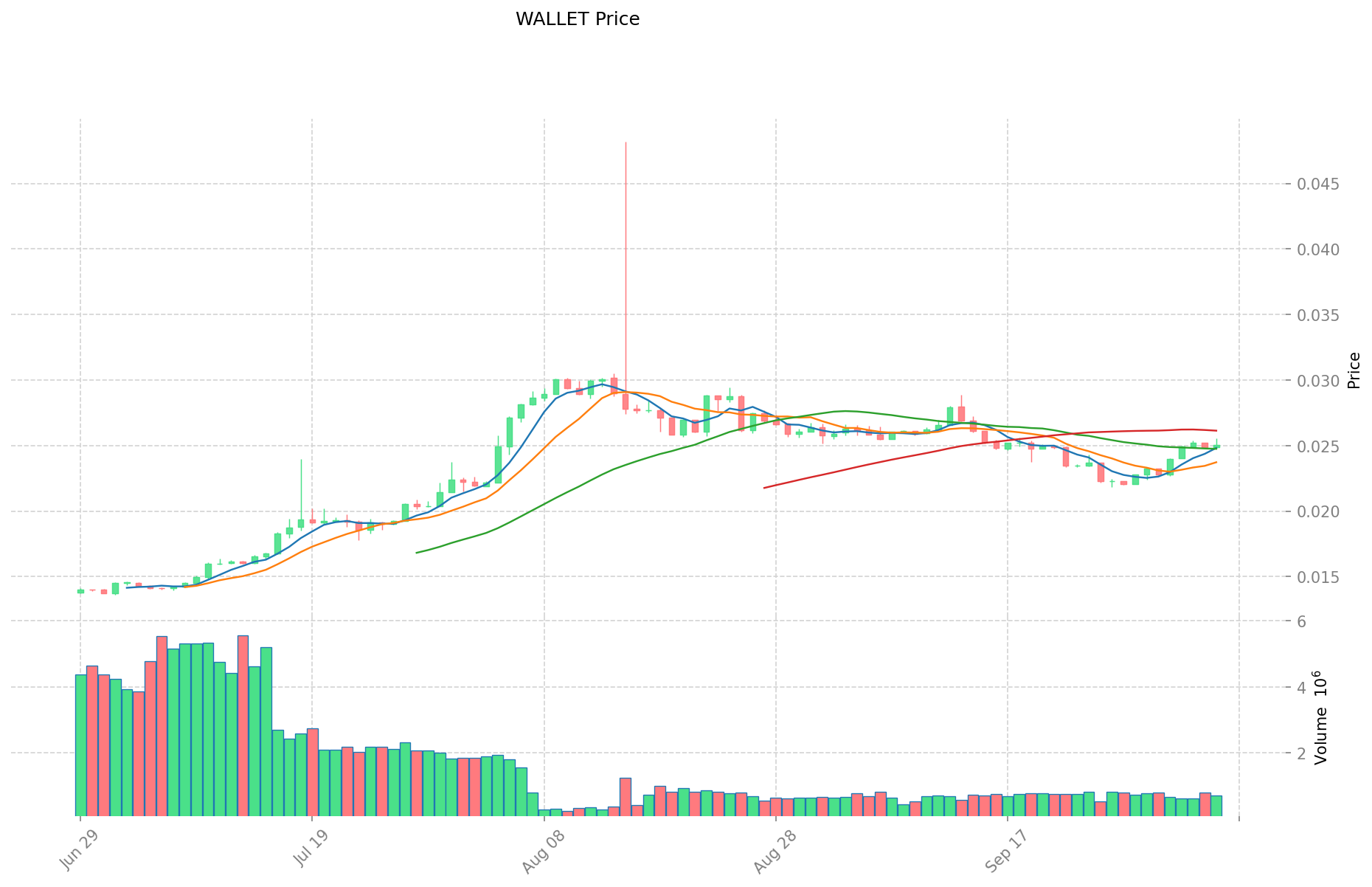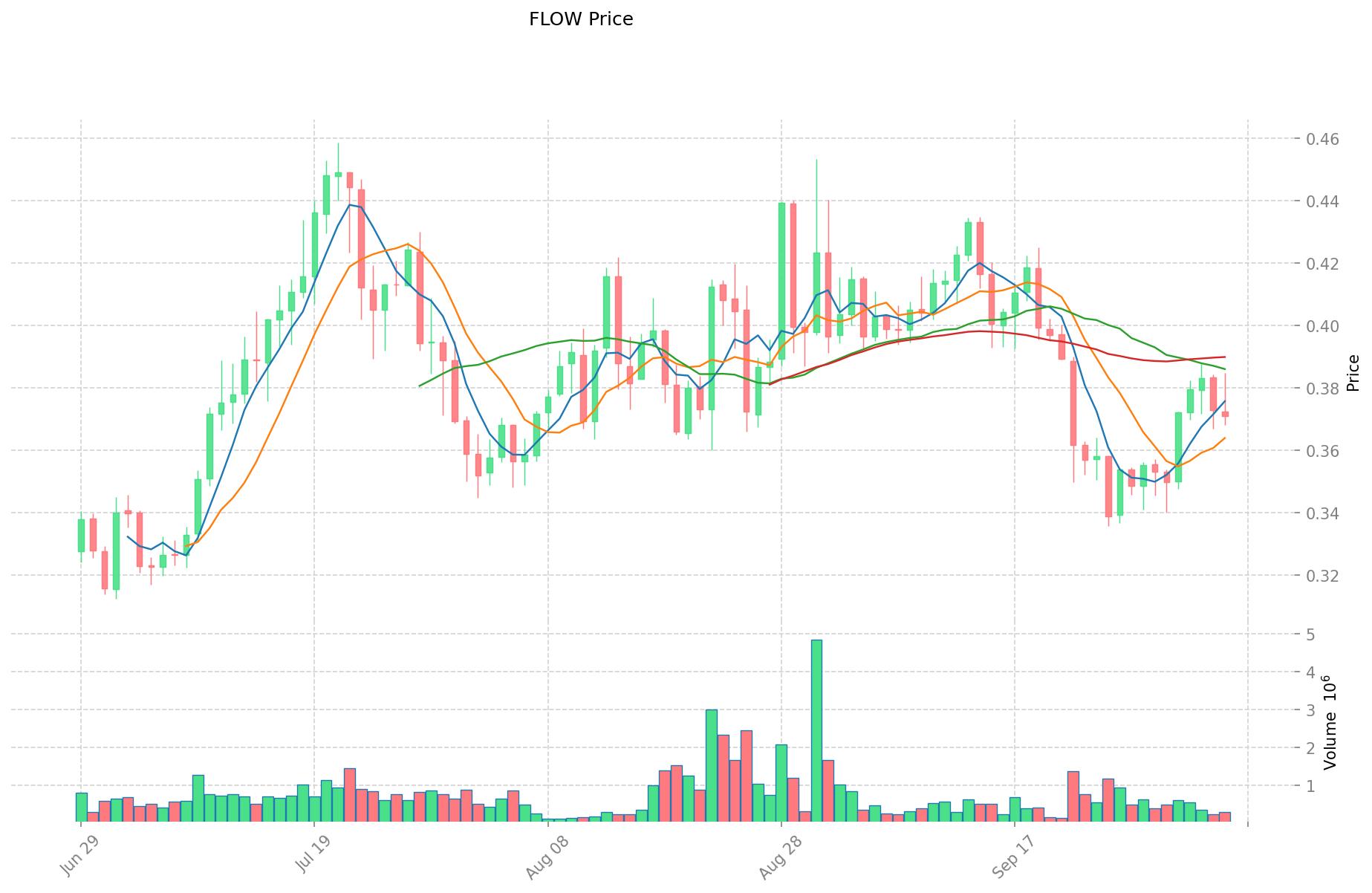WALLET vs FLOW: Understanding the Key Differences Between Static Storage and Dynamic Asset Management
Introduction: WALLET vs FLOW Investment Comparison
In the cryptocurrency market, the comparison between WALLET and FLOW has always been an unavoidable topic for investors. The two not only show significant differences in market cap ranking, application scenarios, and price performance, but also represent different crypto asset positions.
Ambire wallet (WALLET): Since its launch, it has gained market recognition for its browser-based cryptocurrency wallet application.
FLOW (FLOW): Since its inception in 2020, it has been hailed as a platform for next-generation games, applications, and digital assets, becoming one of the cryptocurrencies with high global trading volume and market capitalization.
This article will comprehensively analyze the investment value comparison between WALLET and FLOW, focusing on historical price trends, supply mechanisms, institutional adoption, technological ecosystems, and future predictions, and attempt to answer the question that investors care about most:
"Which is the better buy right now?"
I. Price History Comparison and Current Market Status
WALLET (Coin A) and FLOW (Coin B) Historical Price Trends
- 2022: WALLET reached its all-time high of $0.199652 on February 4, 2022.
- 2021: FLOW peaked at $42.4 on April 5, 2021, marking its all-time high.
- Comparative analysis: In the recent market cycle, WALLET dropped from its high of $0.199652 to a low of $0.00329061, while FLOW declined from $42.4 to its current price of $0.371.
Current Market Situation (2025-10-06)
- WALLET current price: $0.025043
- FLOW current price: $0.371
- 24-hour trading volume: WALLET $17,439.42 vs FLOW $108,189.31
- Market Sentiment Index (Fear & Greed Index): 74 (Greed)
Click to view real-time prices:
- Check WALLET current price Market Price
- Check FLOW current price Market Price


II. Core Factors Affecting WALLET and FLOW Investment Value
Supply Mechanisms Comparison (Tokenomics)
- WALLET: Value determined by supply and demand factors
- FLOW: Value subject to significant fluctuations due to market conditions
- 📌 Historical Pattern: Price volatility closely monitored by investors and traders for buying, selling, or trading decisions
Institutional Adoption and Market Applications
- Institutional Holdings: Some large crypto institutions like Jump Crypto have withdrawn significant funds from exchanges in recent weeks
- Enterprise Adoption: Best Wallet can function as a cryptocurrency trading platform, allowing users to buy and sell cryptocurrencies with fiat currency
- Regulatory Attitudes: Regulatory developments significantly impact token values alongside market conditions and investor sentiment
Technical Development and Ecosystem Building
- WALLET: Standard wallet functionalities plus staking features and token launchpad that allows users to invest in cryptocurrency ICOs
- FLOW: Technical progress is a key factor affecting value fluctuations
- Ecosystem Comparison: Flow Traders mentioned among market makers selling Ethereum in August, indicating active participation in crypto markets
Macroeconomic Factors and Market Cycles
- Performance in Inflationary Environment: Value highly dependent on investor sentiment and market conditions
- Macroeconomic Policy Impact: Technical progress and market maturity closely related to the potential of new altcoin waves
- Community and Governance: Utility tokens derive value from their role in building communities and functioning in DAO governance
III. 2025-2030 Price Prediction: WALLET vs FLOW
Short-term Prediction (2025)
- WALLET: Conservative $0.023-$0.025 | Optimistic $0.025-$0.030
- FLOW: Conservative $0.348-$0.370 | Optimistic $0.370-$0.537
Mid-term Prediction (2027)
- WALLET may enter a growth phase, with prices estimated at $0.021-$0.044
- FLOW may enter a bullish market, with prices estimated at $0.361-$0.751
- Key drivers: Institutional capital inflow, ETF, ecosystem development
Long-term Prediction (2030)
- WALLET: Base scenario $0.026-$0.047 | Optimistic scenario $0.047-$0.060
- FLOW: Base scenario $0.488-$0.708 | Optimistic scenario $0.708-$0.750
Disclaimer
WALLET:
| 年份 | 预测最高价 | 预测平均价格 | 预测最低价 | 涨跌幅 |
|---|---|---|---|---|
| 2025 | 0.0300348 | 0.025029 | 0.02302668 | 0 |
| 2026 | 0.033588918 | 0.0275319 | 0.024228072 | 9 |
| 2027 | 0.04400698896 | 0.030560409 | 0.02108668221 | 22 |
| 2028 | 0.054061363521 | 0.03728369898 | 0.0283356112248 | 48 |
| 2029 | 0.04841288312553 | 0.0456725312505 | 0.023292990937755 | 82 |
| 2030 | 0.059744238128779 | 0.047042707188015 | 0.026343916025288 | 87 |
FLOW:
| 年份 | 预测最高价 | 预测平均价格 | 预测最低价 | 涨跌幅 |
|---|---|---|---|---|
| 2025 | 0.53679 | 0.3702 | 0.347988 | 0 |
| 2026 | 0.67570755 | 0.453495 | 0.3990756 | 22 |
| 2027 | 0.75091969575 | 0.564601275 | 0.361344816 | 52 |
| 2028 | 0.69064850964375 | 0.657760485375 | 0.33545784754125 | 77 |
| 2029 | 0.741624947260312 | 0.674204497509375 | 0.505653373132031 | 81 |
| 2030 | 0.750389605727934 | 0.707914722384843 | 0.488461158445542 | 90 |
IV. Investment Strategy Comparison: WALLET vs FLOW
Long-term vs Short-term Investment Strategies
- WALLET: Suitable for investors focused on wallet applications and ecosystem potential
- FLOW: Suitable for investors seeking growth in gaming and digital asset platforms
Risk Management and Asset Allocation
- Conservative investors: WALLET: 30% vs FLOW: 70%
- Aggressive investors: WALLET: 60% vs FLOW: 40%
- Hedging tools: Stablecoin allocation, options, cross-currency portfolio
V. Potential Risk Comparison
Market Risks
- WALLET: High volatility due to lower market cap and trading volume
- FLOW: Susceptible to broader crypto market trends and gaming industry fluctuations
Technical Risks
- WALLET: Scalability, network stability
- FLOW: Network congestion during high-demand periods, potential smart contract vulnerabilities
Regulatory Risks
- Global regulatory policies may impact both tokens differently, with FLOW potentially facing more scrutiny due to its gaming and NFT focus
VI. Conclusion: Which Is the Better Buy?
📌 Investment Value Summary:
- WALLET advantages: Browser-based wallet application, staking features, token launchpad
- FLOW advantages: Established platform for games and digital assets, higher trading volume and market cap
✅ Investment Advice:
- New investors: Consider a balanced approach with a higher allocation to FLOW due to its more established market position
- Experienced investors: Explore opportunities in both tokens, with a focus on WALLET's growth potential
- Institutional investors: Evaluate FLOW for its market liquidity and WALLET for potential early-stage growth
⚠️ Risk Warning: The cryptocurrency market is highly volatile, and this article does not constitute investment advice. None
VII. FAQ
Q1: What are the main differences between WALLET and FLOW? A: WALLET is a browser-based cryptocurrency wallet with staking features and a token launchpad, while FLOW is a platform for next-generation games, applications, and digital assets. FLOW has a higher market cap, trading volume, and is more established in the crypto market.
Q2: Which token has shown better historical price performance? A: FLOW has shown better historical price performance, reaching an all-time high of $42.4 in April 2021, compared to WALLET's all-time high of $0.199652 in February 2022. However, both have experienced significant price declines since their peaks.
Q3: What are the key factors affecting the investment value of WALLET and FLOW? A: Key factors include supply mechanisms, institutional adoption, technical development, ecosystem building, macroeconomic factors, and market cycles. Both tokens are influenced by market conditions, investor sentiment, and regulatory developments.
Q4: How do the future price predictions compare for WALLET and FLOW? A: By 2030, WALLET is predicted to reach $0.026-$0.060, while FLOW is predicted to reach $0.488-$0.750. FLOW generally shows higher potential price growth in the long-term predictions.
Q5: What are the main risks associated with investing in WALLET and FLOW? A: Both tokens face market risks due to volatility, technical risks related to scalability and network stability, and regulatory risks. WALLET may have higher volatility due to its lower market cap, while FLOW may face more scrutiny due to its focus on gaming and NFTs.
Q6: How should investors approach asset allocation between WALLET and FLOW? A: Conservative investors might consider allocating 30% to WALLET and 70% to FLOW, while aggressive investors might allocate 60% to WALLET and 40% to FLOW. The exact allocation should depend on individual risk tolerance and investment goals.
Q7: Which token is considered a better buy for different types of investors? A: New investors might prefer a higher allocation to FLOW due to its established market position. Experienced investors could explore opportunities in both tokens, focusing on WALLET's growth potential. Institutional investors might evaluate FLOW for market liquidity and WALLET for early-stage growth potential.
Share
Content